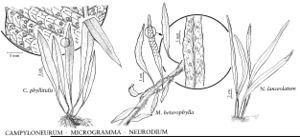Campyloneurum
Tent. Pterid. 189. 1836.
| Taxon | Illustrator ⠉ | |
|---|---|---|
 | Microgramma heterophylla Campyloneurum phyllitidis Neurodium lanceolatum | John Myers John Myers John Myers |
Plants epiphytic. Stems short to long-creeping, branched, 2–10 mm diam., sometimes whitish pruinose; scales brown, ovate, often clathrate, entire. Leaves monomorphic, tufted, conspicuously narrowed to tip, to 150 cm. Petiole absent or present, articulate to stem. Blade linear to lanceolate or elliptic, simple, glabrous, sparsely scaly, margins entire; scales clathrate, basifixed. Primary-veins connected by 1–several secondary-veins (cross-veins), forming 1–several areoles between each pair of primary-veins, areoles with 1–4 excurrent veinlets, sometimes these excurrent veinlets dividing areoles completely. Sori in 1–10 rows between midrib and margin, terminal on included veinlets, discrete, round; indument absent. Spores verrucose to nearly psilate. x = 37.
Distribution
Tropical, North America, Mexico, West Indies, Central America, South America
Discussion
Species ca. 25–50 (4 in the flora).
Selected References
Lower Taxa
Key
| 1 | Primary veins obscure and slightly to strongly curved; blades generally less than 6 cm wide. | > 2 |
| 1 | Primary veins conspicuous and straight to slightly curved; blades generally more than 6 cm wide. | > 3 |
| 2 | Blades more than 2 cm wide, margins shallowly sinuate to undulate, not revolute; areoles in 4–8 series between costa and margin; petioles always present. | Campyloneurum costatum |
| 2 | Blades less than 2 cm wide, margins revolute, not shallowly sinuate to undulate; areoles in 1–4 series between costa and margin; petioles present or absent. | Campyloneurum angustifolium |
| 3 | Petioles absent to ca. 9 cm; blades yellow-green, margins entire and plane to lightly undulate. | Campyloneurum phyllitidis |
| 3 | Petioles 5–18 cm; blades dark green, margins undulate. | Campyloneurum latum |